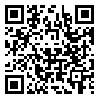دوره 23، شماره 2 - ( 5-1404 )
جلد 23 شماره 2 صفحات 56-49 |
برگشت به فهرست نسخه ها
Research code: IR.UMSU.REC.1402.283
Ethics code: IR.UMSU.REC.1402.283
Download citation:
BibTeX | RIS | EndNote | Medlars | ProCite | Reference Manager | RefWorks
Send citation to:



BibTeX | RIS | EndNote | Medlars | ProCite | Reference Manager | RefWorks
Send citation to:
Yousefi Asl M, Baghaei R, Javan Hoshyar J, Alinejad V, Haghighi M, Gholami G. Investigating the relationship between religiosity and spirituality with anxiety, depression, and stress levels among nursing students at Urmia University of Medical Sciences in 2024. Nursing and Midwifery Journal 2025; 23 (2) :49-56
URL: http://unmf.umsu.ac.ir/article-1-5351-fa.html
URL: http://unmf.umsu.ac.ir/article-1-5351-fa.html
Investigating the relationship between religiosity and spirituality with anxiety, depression, and stress levels among nursing students at Urmia University of Medical Sciences in 2024. مجله پرستاری و مامایی. 1404; 23 (2) :49-56
: (90 مشاهده)
Background This study aimed to investigate the relationship between religiosity and spirituality with anxiety, depression, and stress levels among nursing students at Urmia University of Medical Sciences.
Methods The present study was a descriptive-analytical and cross-sectional study. The statistical population consisted of 200 undergraduate nursing students at Urmia University of Medical Sciences in the academic year 2024. Male and female students were selected via simple random sampling. Data were collected using the Khodayari Fard Religious Attitude Questionnaire, Hall and Edwards Spirituality Questionnaire, Depression, Anxiety, and Stress Scale (DASS-21) Questionnaire, and a demographic characteristics questionnaire. Data analysis was performed using descriptive statistics and SPSS software (version 22.0).
Results Results demonstrated a significant inverse relationship between religiosity and spirituality and levels of anxiety, depression, and stress (p < 0.001). Students with higher levels of religiosity and spirituality reported lower levels of anxiety, depression, and stress.
Conclusion The results of this study can help better understand the impact of religiosity and spirituality on students’ mental health and provide strategies to improve their mental well-being. These results can be a basis for policies and educational and support programs in universities to reduce anxiety, depression, and stress in students. Thus, the results of this study can be used to improve students’ mental health and increase the scientific community’s awareness of the importance of religiosity and spirituality.
Methods The present study was a descriptive-analytical and cross-sectional study. The statistical population consisted of 200 undergraduate nursing students at Urmia University of Medical Sciences in the academic year 2024. Male and female students were selected via simple random sampling. Data were collected using the Khodayari Fard Religious Attitude Questionnaire, Hall and Edwards Spirituality Questionnaire, Depression, Anxiety, and Stress Scale (DASS-21) Questionnaire, and a demographic characteristics questionnaire. Data analysis was performed using descriptive statistics and SPSS software (version 22.0).
Results Results demonstrated a significant inverse relationship between religiosity and spirituality and levels of anxiety, depression, and stress (p < 0.001). Students with higher levels of religiosity and spirituality reported lower levels of anxiety, depression, and stress.
Conclusion The results of this study can help better understand the impact of religiosity and spirituality on students’ mental health and provide strategies to improve their mental well-being. These results can be a basis for policies and educational and support programs in universities to reduce anxiety, depression, and stress in students. Thus, the results of this study can be used to improve students’ mental health and increase the scientific community’s awareness of the importance of religiosity and spirituality.
| بازنشر اطلاعات | |
 |
این مقاله تحت شرایط Creative Commons Attribution-NonCommercial 4.0 International License قابل بازنشر است. |




 umsu.ac.ir ,
umsu.ac.ir , 